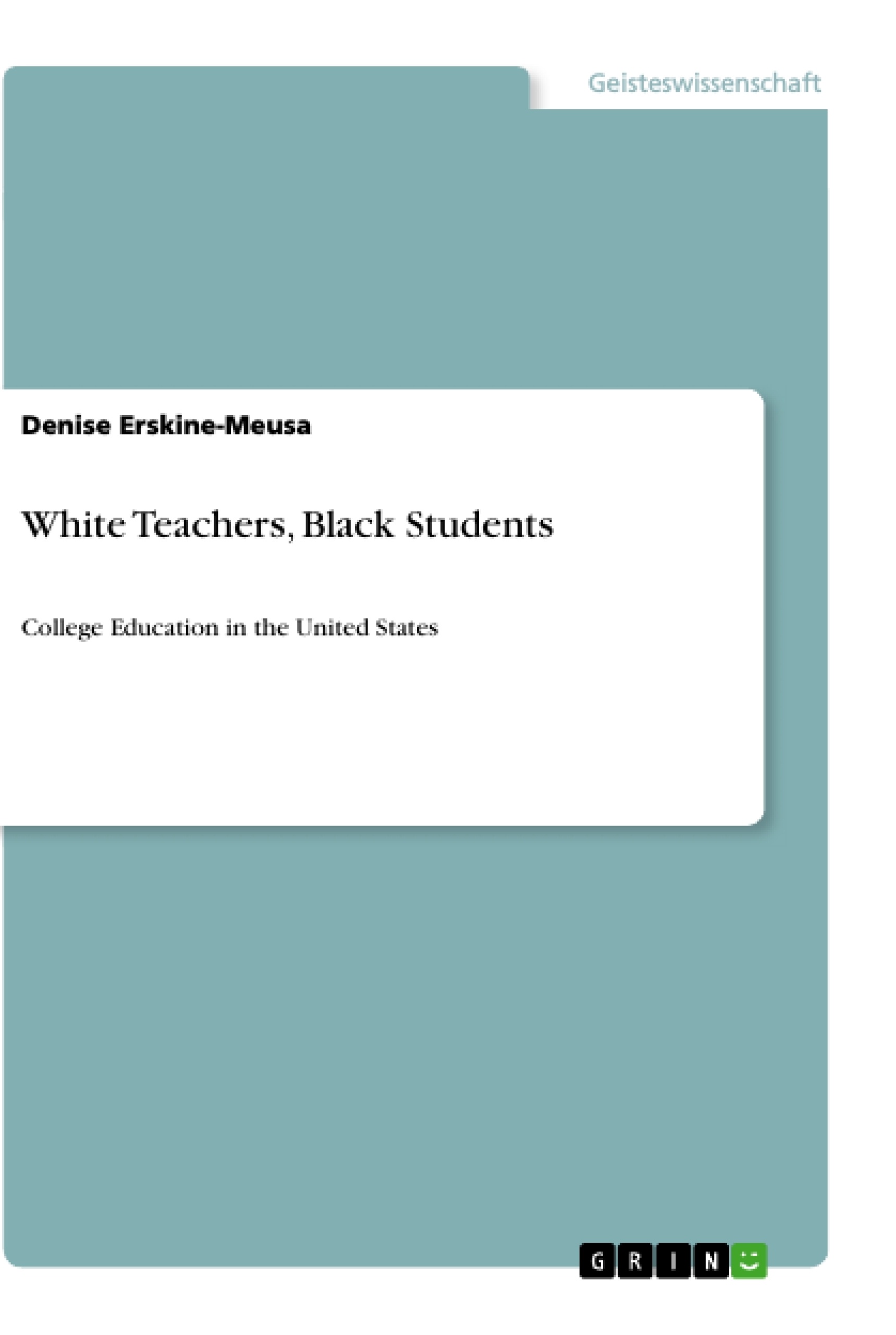I wrote "White Teachers, Black Students" to highlight the ways that Black college students can be taught by all teachers, but White teachers, specifically. Because White teachers dominate the teaching staff in education at all levels, it is imperative to provide rumbustious conversations about how to effectively teach Black college students, especially when they are not graduating at the rate of their White counterparts. "White Teachers, Black Students" provides a vision and recommendations for changing the way that Black college students have traditionally been taught. Creating a dialogue for a cultural shift in how Black students learn in the college classroom can contribute toward a heightened level of sensitivity for teaching and learning that reflects a more diverse and inclusive society. This book is about reimagining how Black students can learn in the classroom, through culturally responsive pedagogy, and not hand—me—down teaching pedagogy. Updating classroom techniques for teaching and learning will not only impact a student’s ability to live the American dream and find a job, but also revolutionize their innate capacity for engaging in critical thinking in ways that positively impact how they exercise conscious control over their everyday lives.
Inhaltsverzeichnis
- Vorwort
- Teil I: Lehren aus meinem Klassenzimmer
- Kapitel I: Wer ich bin
- Teil II: Meine Forschung
- Kapitel II: Das Problem; Konzeptionelles Gerüst
- Kapitel III: Erfahrungen von Afroamerikanischen Community College Studenten im Klassenzimmer
- Kapitel IV: Forschungsmethode; Forschungsprozess; Die Bühne bereiten: Diop Community College; Treffen Sie die Teilnehmer; Schülergeschichten
- Kapitel V: Ergebnisse; Bedeutsame Themen der Schülererzählungen; Identifizierung und Anwendung von CPE-Themen
- Kapitel VI: Zusammenfassung und Schlussfolgerung; Bezug zur Literatur; Empfehlungen für die Praxis; Empfehlungen für weitere Forschung; Nachwort
Zielsetzung und Themenschwerpunkte
Diese Arbeit untersucht die Erfahrungen von Afroamerikanischen Studenten an Community Colleges im Klassenzimmer und analysiert diese im Kontext kulturell relevanter Pädagogik. Das Hauptziel ist es, die Herausforderungen und Erfolge dieser Studenten aufzuzeigen und daraus Empfehlungen für die Praxis und zukünftige Forschung abzuleiten.
- Erfahrungen von Afroamerikanischen Community College Studenten
- Kulturell relevante Pädagogik im Hochschulkontext
- Herausforderungen und Erfolge im Unterricht
- Empfehlungen für Lehrkräfte und Institutionen
- Analyse von Schülererzählungen
Zusammenfassung der Kapitel
Kapitel I: Wer ich bin: Dieses Kapitel bietet eine persönliche Einführung der Autorin und beschreibt ihre Erfahrungen als Dozentin an einem Community College. Es legt den Grundstein für die gesamte Arbeit, indem es den Kontext der Forschung und die Motivation der Autorin beleuchtet. Die persönlichen Anekdoten der Autorin liefern Einblicke in ihre pädagogische Philosophie und ihr Verständnis der Herausforderungen, denen Afroamerikanische Studenten gegenüberstehen.
Kapitel II: Das Problem; Konzeptionelles Gerüst: Kapitel II beschreibt das zentrale Problem der Arbeit: die Erfahrungen von Afroamerikanischen Studenten an Community Colleges. Es etabliert ein konzeptionelles Gerüst, das die theoretischen Grundlagen der Forschung erläutert und den Rahmen für die Analyse der Daten liefert. Dieses Kapitel verbindet die persönlichen Erfahrungen der Autorin mit etablierten Theorien der kulturell relevanten Pädagogik und legt so die Basis für die folgenden Kapitel.
Kapitel III: Erfahrungen von Afroamerikanischen Community College Studenten im Klassenzimmer: In Kapitel III werden die Erfahrungen von Afroamerikanischen Community College Studenten im Detail beschrieben. Es werden die spezifischen Herausforderungen beleuchtet, mit denen diese Studenten konfrontiert sind, und es werden Beispiele aus der Literatur und aus den persönlichen Erfahrungen der Autorin gegeben, um diese Herausforderungen zu illustrieren. Dieses Kapitel bietet einen umfassenden Überblick über die Thematik und bereitet den Boden für die nachfolgende Forschungsanalyse.
Kapitel IV: Forschungsmethode; Forschungsprozess; Die Bühne bereiten: Diop Community College; Treffen Sie die Teilnehmer; Schülergeschichten: Kapitel IV beschreibt die gewählte Forschungsmethodik, den Forschungsprozess und die Studiendesigns. Es erläutert die Auswahl der Stichprobe, den Forschungsort (Diop Community College) und stellt die Teilnehmer vor. Der Schwerpunkt liegt auf der Beschreibung der Datenerhebung und -analyse, inklusive der Schülergeschichten, die als Grundlage der Forschung dienen. Die Detaillierung der Methodik gewährleistet die Nachvollziehbarkeit und die wissenschaftliche Validität der Ergebnisse.
Kapitel V: Ergebnisse; Bedeutsame Themen der Schülererzählungen; Identifizierung und Anwendung von CPE-Themen: In Kapitel V werden die Ergebnisse der Forschung präsentiert und interpretiert. Die bedeutsamen Themen, die aus den Schülererzählungen hervorgegangen sind, werden detailliert beschrieben und analysiert. Es wird gezeigt, wie diese Themen mit dem Konzept der kulturell relevanten Pädagogik (CPE) in Verbindung stehen und wie sie angewendet werden können, um den Bedürfnissen der Studenten besser gerecht zu werden. Die Ergebnisse werden umfassend erläutert und mit Bezug auf die Forschungsliteratur diskutiert.
Schlüsselwörter
Afroamerikanische Studenten, Community Colleges, kulturell relevante Pädagogik, Hochschulbildung, Schülererfahrungen, qualitative Forschung, Unterrichtspraxis, Herausforderungen, Erfolge.
Häufig gestellte Fragen zur Arbeit: Erfahrungen Afroamerikanischer Studenten an Community Colleges
Was ist der Gegenstand dieser Arbeit?
Diese Arbeit untersucht die Erfahrungen von Afroamerikanischen Studenten an Community Colleges im Klassenzimmer und analysiert diese im Kontext kulturell relevanter Pädagogik. Das Hauptziel ist es, die Herausforderungen und Erfolge dieser Studenten aufzuzeigen und daraus Empfehlungen für die Praxis und zukünftige Forschung abzuleiten.
Welche Themen werden behandelt?
Die Arbeit behandelt Themen wie die Erfahrungen von Afroamerikanischen Community College Studenten, kulturell relevante Pädagogik im Hochschulkontext, Herausforderungen und Erfolge im Unterricht, Empfehlungen für Lehrkräfte und Institutionen sowie die Analyse von Schülererzählungen.
Welche Kapitel umfasst die Arbeit?
Die Arbeit gliedert sich in zwei Teile. Teil I beinhaltet ein einleitendes Kapitel ("Wer ich bin"), das die Autorin und ihre Motivation vorstellt. Teil II umfasst die Forschungsarbeit, aufgeteilt in Kapitel II (Problem und konzeptionelles Gerüst), Kapitel III (Erfahrungen der Studenten), Kapitel IV (Forschungsmethode und -prozess), Kapitel V (Ergebnisse und Analyse) und Kapitel VI (Zusammenfassung, Schlussfolgerung und Empfehlungen).
Welche Forschungsmethode wurde verwendet?
Kapitel IV beschreibt detailliert die gewählte qualitative Forschungsmethodik, den Forschungsprozess, die Studiendesigns, die Auswahl der Stichprobe (am Diop Community College), die Datenerhebung (inkl. Schülergeschichten) und die Datenanalyse. Die detaillierte Beschreibung der Methodik soll die Nachvollziehbarkeit und wissenschaftliche Validität der Ergebnisse gewährleisten.
Welche Ergebnisse wurden erzielt?
Kapitel V präsentiert und interpretiert die Ergebnisse der Forschung. Es beschreibt und analysiert bedeutsame Themen aus den Schülererzählungen und zeigt deren Verbindung zum Konzept der kulturell relevanten Pädagogik (CPE) auf. Die Ergebnisse werden umfassend erläutert und mit Bezug auf die Forschungsliteratur diskutiert.
Welche Schlussfolgerungen und Empfehlungen werden gezogen?
Kapitel VI fasst die Ergebnisse zusammen, zieht Schlussfolgerungen und gibt Empfehlungen für die Praxis (für Lehrkräfte und Institutionen) sowie für weitere Forschung. Es besteht auch ein Bezug zur bereits bestehenden Literatur.
Wer ist die Autorin?
Kapitel I bietet eine persönliche Einführung der Autorin und beschreibt ihre Erfahrungen als Dozentin an einem Community College. Es legt den Grundstein für die gesamte Arbeit, indem es den Kontext der Forschung und die Motivation der Autorin beleuchtet.
Welche Schlüsselwörter beschreiben die Arbeit?
Schlüsselwörter sind: Afroamerikanische Studenten, Community Colleges, kulturell relevante Pädagogik, Hochschulbildung, Schülererfahrungen, qualitative Forschung, Unterrichtspraxis, Herausforderungen, Erfolge.
- Citar trabajo
- Denise Erskine-Meusa (Autor), 2019, White Teachers, Black Students, Múnich, GRIN Verlag, https://www.grin.com/document/947000




